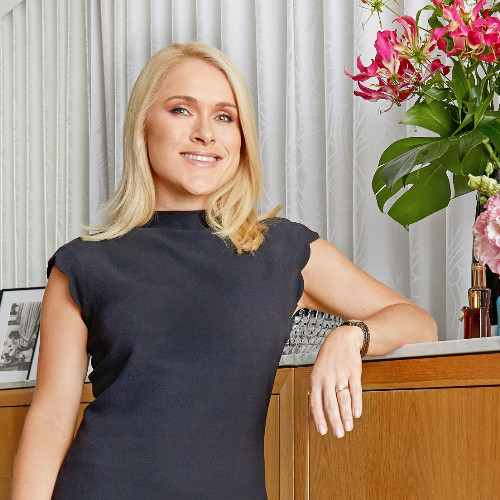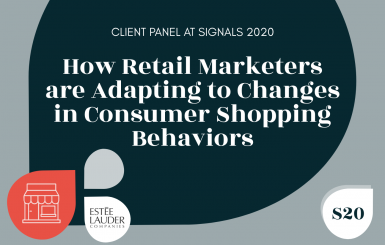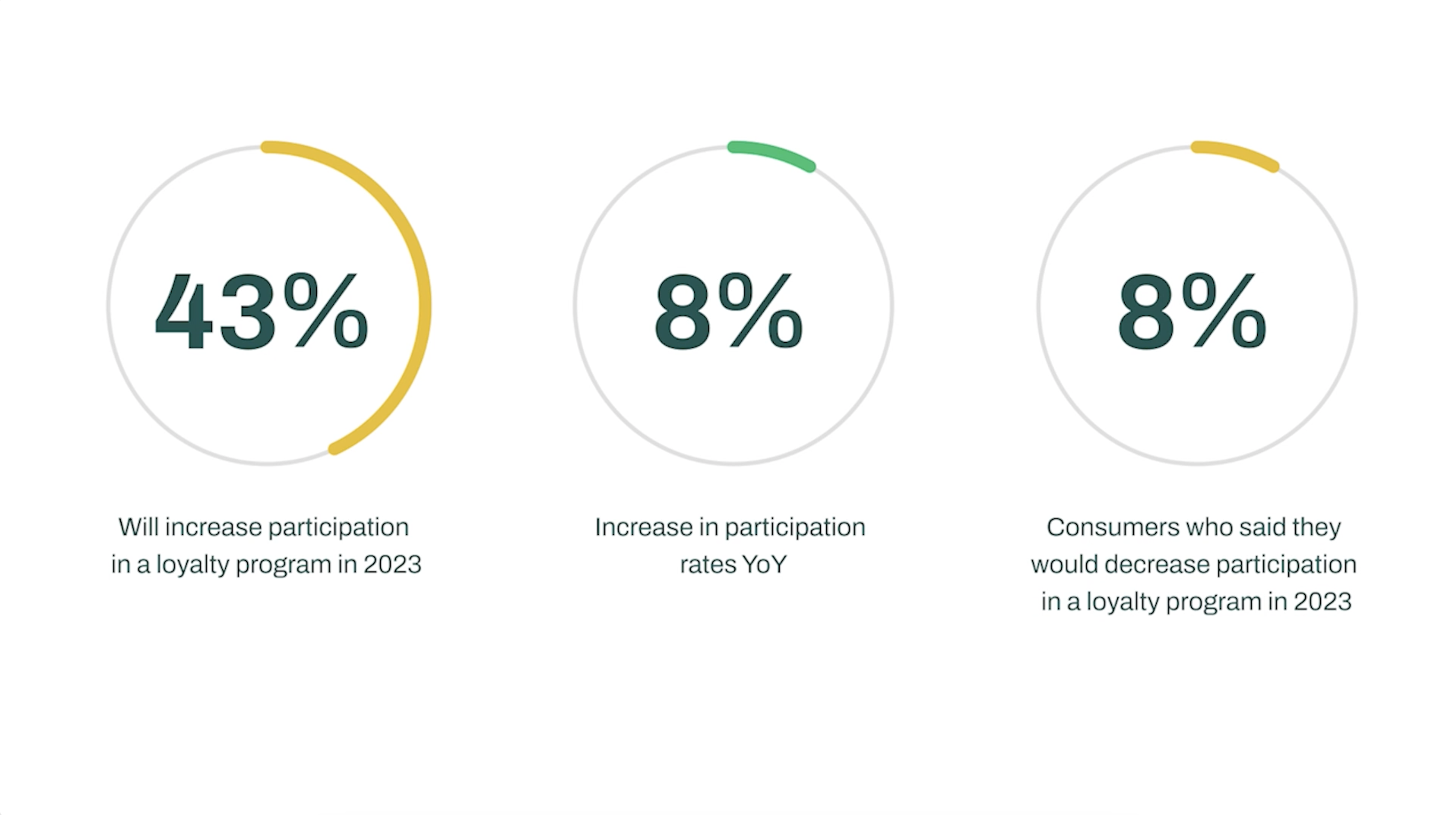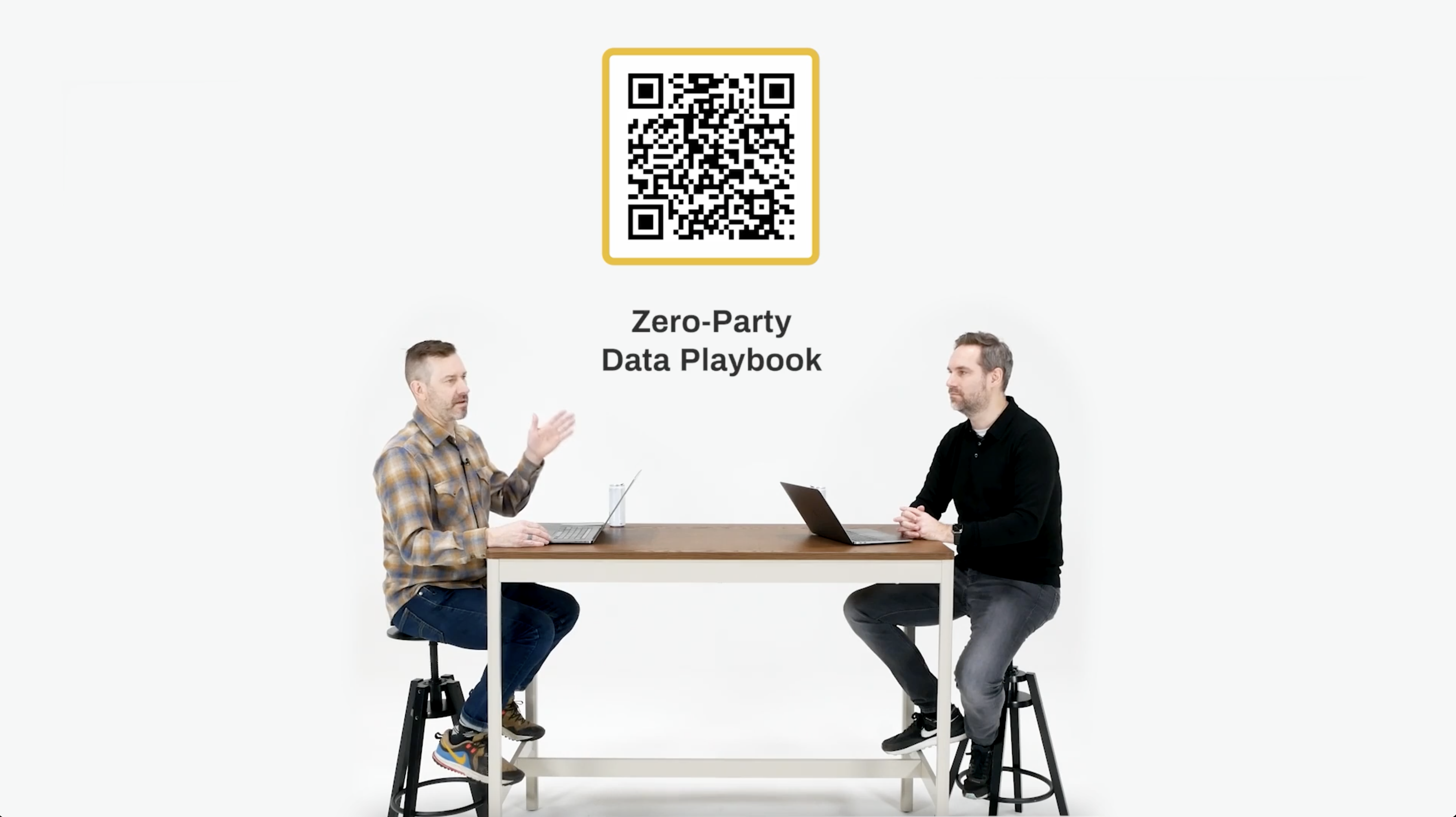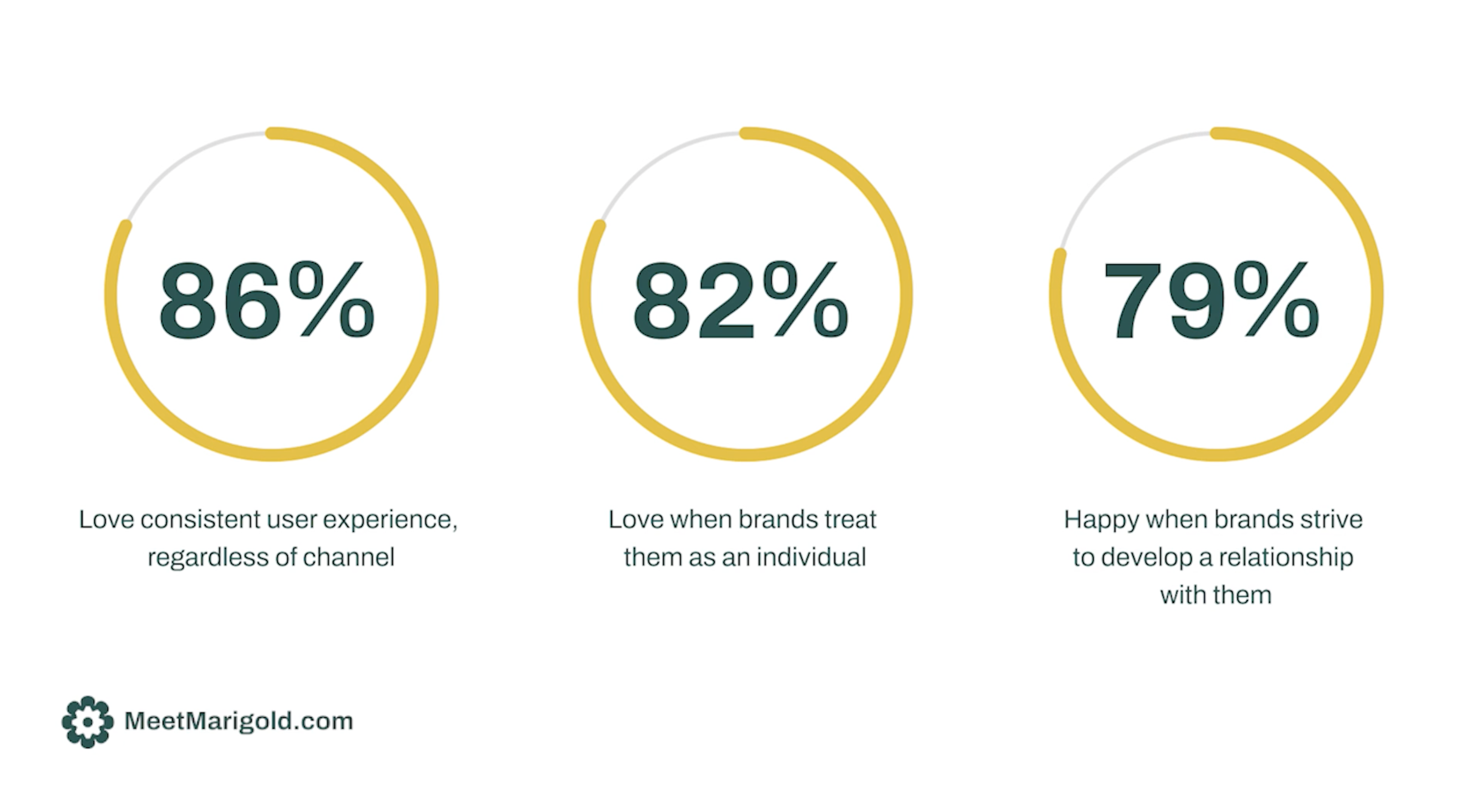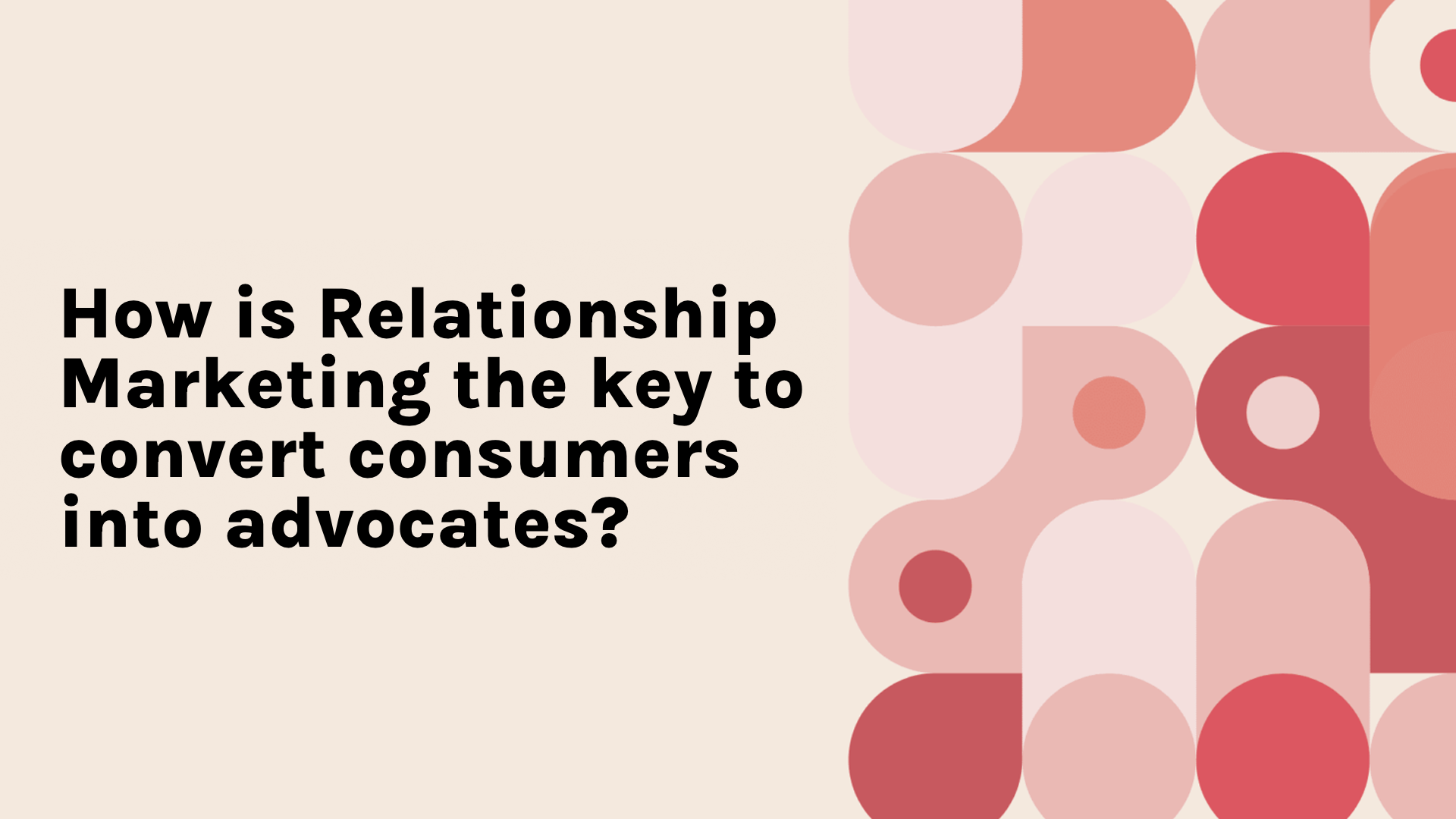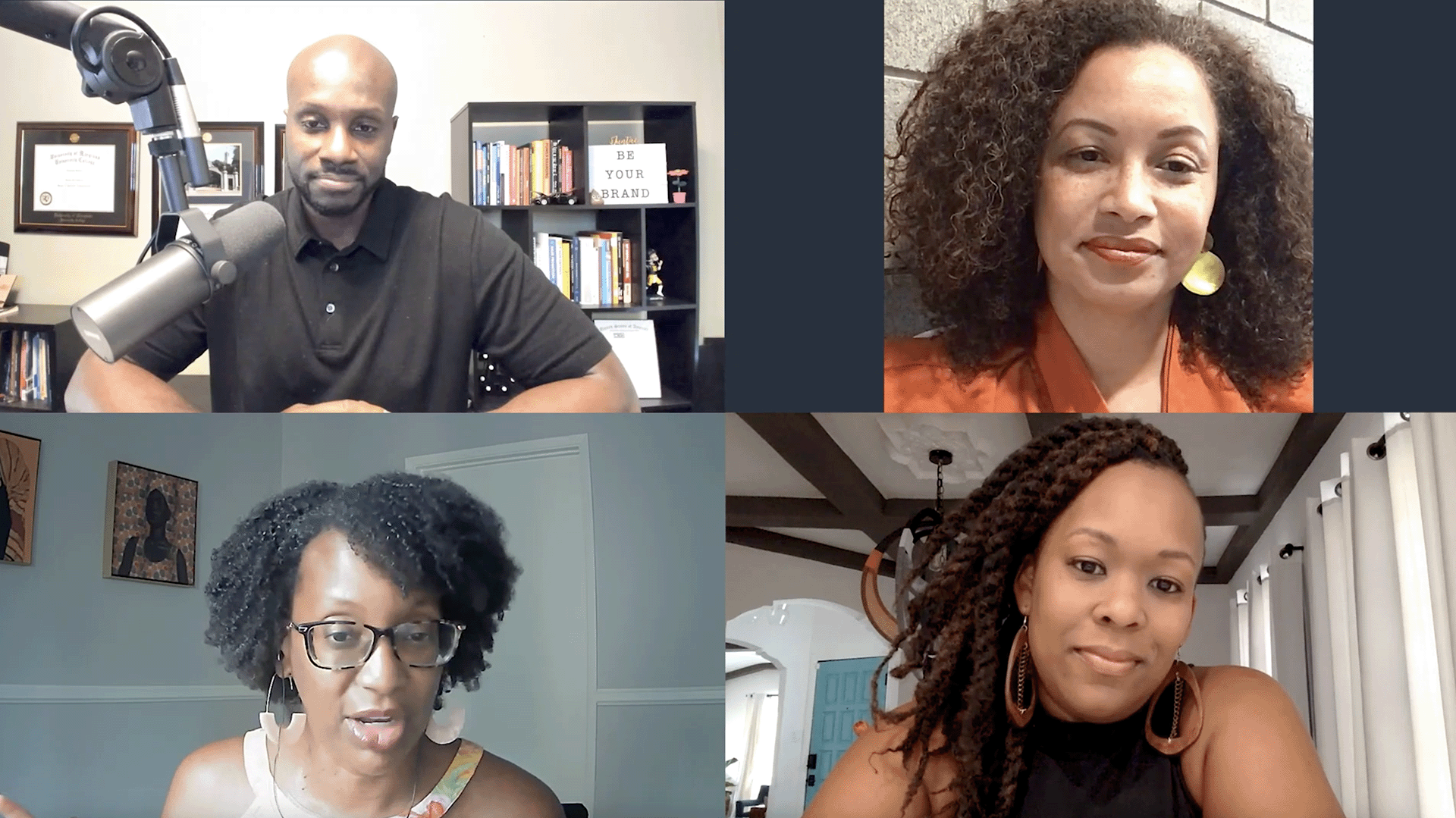How retail marketers are adapting to extraordinary changes in consumer shopping behaviors
- 0.5
- 1
- 1.25
- 1.5
- 1.75
- 2
Julian: Kayla.
Kayla: Yes, Julz.
Julian: As The Strokes tried to tell us back in 2001, this is it.
Kayla: It is. Somehow we have made it to the end of Signals 2020, inaudible.
Julian: And we're here to talk about the retail industry.
Kayla: We are. But this week, I think we should bow out in style.
Julian: What do you have up your sleeves then?
Kayla: Well, I think I found the perfect matching outfits for us. Should I buy them?
Julian: Absolutely. If you think they'll get here on time.
Kayla: Wow. That was fast. Bands is going to inaudible this.
Julian: Wow, look at this.
Kayla: Well, open it up. We do have a inaudible to host Let's go.
Julian: All right. It's not even a cheetah.
Kayla: Well, do you like it?
Julian: No. I love it.
Kayla: Awesome. I thought you would.
Julian: It's impressively soft too. Bands have gotten some business hours during Signals.
Kayla: They have. For the past two weeks, our CEO, our CTO, and our CMO have all been off the wall.
Julian: MVP, WJD, WWID.
Kayla: What?
Julian: Most valuable player. What would Julian do? Who wore it best? Obviously.
Kayla: Well, for the last one, let's let the audience decide. But for once I really don't want to change in my 2D form.
Julian: Oh, no. But change we must. We move towards the inaudible Kyle. Here it goes. Kayla, could you introduce our topic and final guest?
Kayla: Yes, I can. Today we're talking about how retail marketers like Estee Lauder are adapting to extraordinary changes in consumer shopping behavior.
Julian: So first Katherine. Thank you very much in joining Kayla and myself today. Could you just set us up by introducing yourself, the role that you work at Estee and a little bit about some of the stuff that you guys are doing.
Katherine: Sure. Hi, thanks for having me. I'm very honored to be here. My name is Katherine Mamontoff. I'm the online and omnichannel General Manager at Estee Lauder companies. Our team looks after everything that has to do with the online business. We have seven of our own brand. com sites, which is direct to consumer. And then we also work with our retail partners on how we can bring our brands best to life on their online channels. As part of our remit, we also look after what we call omnichannel, and that is obviously how you connect the online to the offline world. And for us, that's things like booking a makeup appointment online, or buying and using a gift cards online or in store or buying a foundation online finding that it's not the right shade for you, and taking it into store to exchange it for a shade that might be more suited to your skin tone. We launched our first online site about 13 or 14 years ago, and our company, Estee Lauder companies, is actually the first big brand to launch an online business in the beauty industry some 20 odd years ago. So we like to kind of call ourselves digital pioneers in our industry. And we like to think that we've got a lot of background, a lot of learnings on how to take cosmetics and skincare and hair care to consumers in the online space.
Julian: Could you describe to us a little bit about the omnichannel approach that Estee has been pioneering. And yes, certainly from what you're doing today and where you've taken it.
Katherine: Sure. When Estee Lauder launched online, globally 20 something years ago, people thought we were mad. Nobody is going to buy makeup online. Why would somebody buy lipstick that they hadn't watched on their hands or tried on. Clinique was launched first, and then the other brands followed. And lo and behold, people were buying lipsticks online. And then people said, " Nobody's going to buy foundation online. Foundation is such a personalized product, you need to have an expert try it on your skin and match you to the most relevant color to your skin tone. So nobody's going to buy that online." But guess what? They did. Initially, it was about replenishment. People would go in store for that inial service element, but then they would come and replenish their products online. But we've seen that really change and online, it's our flagship store. And we're using it to really recruit new customers as well as service to our loyal customers. And I think what we've seen, especially over the last three to five years, is social media has really changed the industry as well in a huge, huge way. Now Instagram has really exploded the makeup category online. My Instagram feed... Is probably because that's who I'm following, but it's full of makeup tutorials and people really expressing themselves as artists using makeup. And it's also meant that platform has really helped a lot of indie makeup brands develop a large customer base. In a world where prior to platforms like Instagram, it would be very, very difficult for those smaller indie brands to gain a foothold in what was quite a traditional industry prior. And then within our business, previously... We were quite siloed in the past. You had your bricks and mortar business, and you have your online business. And our business has been around for many, many, many years. And we're very used to selling a lot to a few retailers. Moving a lot of product to just a couple of retailers. And then when we moved online, we really had to change that model completely because now we're selling lots of little items to many thousands of consumers. And online was sort of set up as a separate business to the traditional business in Estee Lauder. And we did that deliberately to really help the online business flourish and not get stuck in the ways that we always did things within the traditional part of the business. But now we need to converge the two, because customers don't see our channels differently. A customer sees us as Estee Lauder or as M.A.C or as Clinique, they see it as one brand. They don't see it as multiple different channels trying to talk to her in different ways. So we're really focusing on bringing our different businesses together, and in using omnichannel as a way to make it easy for her to engage with us in the channel that suits her at that time. Because we know that she may want to go to a counter and have her foundation matched, but she might want to send a gift from online because it's just more convenient that way. So we really focusing on how we bring all of that together, and be the most relevant to her at that time that she wants to shop with us.
Julian: With the audience, you must have quite a different set of pots I imagine, because you describe how your customers, she will be reaching in different ways. Some will probably as you've already mentioned, they prefer the in store stuff, some will prefer getting messages online through social. You make a big effort of trying to cater for all of these different needs.
Katherine: I think the most important lesson that I've learned over the last few years, particularly as I've been focused more on how we bring the channels together and reimagine the shopping experience, is to really keep an open mind and think about what's right for the customer over and above what's right for us as a retailer. And some things that we've tested and learned, may seem kind of hard to fathom that they're going to have a high adoption, but what seems odd at one point in time, can be really different at another point in time. And an example that springs to mind for me personally, is click and collect. When it was first introduced, retailers had initially had their click and collect counters hidden at the back of their stores. So you had to pass everything in the store to get to the counter to collect your item. For them, it was a potential way to maybe make another sale. But for the consumer, it was actually really inconvenient. And at the time, I really struggled to see why anybody would want to use that service. I couldn't even really get my head around, why you'd want to use click and collect over having your groceries delivered to your door. But fast forward a few years, and especially during this time... And I think about the curbside service that retailers are offering now with click and collect when you get your groceries. For me, it's been a game changer. And you understand delivery to your door can happen within a two to four, six hour window, but where click and collect is more at your control. And so my point of that example is people are really looking for either price, convenience, or an experience. And if your retail is ticking one of those boxes, then you probably got a good chance that what you're testing and learning from is going to be onto a winner over the long run.
Kayla: So at a broad level, how are retailers looking to reimagine the shopping experience for their customers, both online and in store?
Katherine: Just touching on what I just spoke about, being where the customer wants to shop with us. For us, this year in particular has been quite an interesting journey, because our company prides ourselves on our service model. And it's actually even in our mission statement, it's about... We call it a high touch service model. But our mission is about bringing the best to everybody we touch. Obviously, that's quite hard to do during COVID period. So we really had to reimagine what that looks like for our business. And in particularly this year, we've had to pivot very, very quickly on how do we bring the best to everyone we touch without actually touching them. And particularly for me in online, where we're obsessed with how do we bring that in store experience into a digital format. And so we're very quickly introduced new technology, and we've accelerated a virtual try- on experience. And how that works is you get your phone, we have AR technology that takes your face, and it matches you to the right foundation for your skin. So you don't have to go into a store and have somebody trying the foundation on your face, you can be doing it virtually. We have the same with lipstick and with eyeshadows. And that technology is not new, it's been around for a number of years now. But it's taken some time to evolve. When it first came out, it looked a bit clown like when you were seeing this lipstick and eyeshadow on your face. But it's now evolved so well that it is so true to life, and it's very, very reliable. So we really encourage consumers to use that tool if they don't want to come into the store. We've also really evolved our consultation process. You can obviously go into store and speak face- to- face with one of our experts, but you can also now choose to have that consultation over video. So you could go onto one of our websites and book a book an appointment. You could still go to a store and have the appointment, absolutely. We love to see people face- to- face. But if you choose, you can also now do it over your phone, on a video call with one of our experts. And it's been really fascinating to see how people's expectations and people's comfort with technology has changed. We introduced live chat on our site some years ago. And at the time, we were testing and learning video chat and uploading the photos, nobody wanted to do that. People wanted to be anonymous, and they just wanted to type their questions, and then leave quickly. But with COVID this year, that's really flipped the model on its head. People have become very, very comfortable with showing their faces, and with having that one- on- one interaction with our hosts, our chat hosts, or our experts. We still do a lot of live events in our retail stores. We've had to scale that back, but what we're doing instead is a putting it online. And so it could either be on Instagram, or it could be hosted on our own brand. com channels. So we've really tried to mirror the experience that you get in store and put it online. But it's not in a way that we wish to... We want to compliment the in- store service, we're not trying to replace that service.
Kayla: So with how you guys have pivoted, and has gone a little bit more digital with everything, how has that affected your ability to reach more people? And then the two parts. So starting from there, and then how have you been able to take those new customers and build that personalized experience?
Katherine: We want to be able to cultivate our customers across an omnichannel experience. And just going back to what I was talking about before, we may be recruiting more consumers now through digital, because stores have been closed or people are not comfortable going into stores. And we've been recruiting them more in the digital space, but we want to be able to offer them that in- store experience when they feel comfortable to do that. But at the same time, we know that the online acceleration is probably not going to go away. Social selling has become a trend not just in our market, but worldwide, and not just in our industry. But we're really testing and learning with what that's going on look like in the long term and how do we scale it so it has a sustainable ROI. And that's something that we... It's not a model that we've we've cracked. I think one of the other interesting factors that we're talking about and thinking about a lot over this period, and especially as we go into Christmas, is customer demands have increased substantially and people really want fast delivery. So we've got this huge demand for fast delivery, and this delivery service that is cracking under the weight of the demand. It's under enormous pressure. So we're trying to think about, how do we get our products to consumers in the fastest way? How can we bring our offline business to help facilitate some of that pressure. So it's not just about the delivery of the product. Yes, our business is about selling product, but it's also about teaching and educating consumers to look and feel their best. And we really believe that there is a role for both of those channels to play in that space. And so we're still continuing to figure out how is the best way to put those two together. And to touch on the second part of your question about personalization. Personalization is really at the heart of everything that we do. That is our business. There's nothing more personalized than offering 65 different shades of foundation or skincare that target individual concerns. It doesn't get much more personalized than that. But from a consumer perspective, we want to get much more granular to be where she wants us, and where she expects us to be when it's relevant for her. Sometimes she might want the self- select model from what you get from like a Sephora or a MECCA. Other times, she might want that full blown beauty advisor service that you tend to get more from department stores. Or she might want to just quickly jump online and order a gift for somebody and really lean on that convenience. So we want to be sure we're offering her that same high touch service, where it makes sense in each of those channels that's in an environment of her choosing at that time.
Kayla: You touched on this a little bit during that question, around you have this new group of customers and they're online now, but you eventually want to bring them in store. So I'm curious, are you guys building an approach around this new persona or group of customers in changing up how you communicate with them versus how you've communicated with your traditional customers?
Katherine: We're certainly moving our communication to a more omnichannel approach. Rather than talking to her by the channel in which she came in, we want to offer her a choice. So she may have come in via our own owned brand. com site. But we don't want to stop her from being exposed to a great offer, or a great event that's going to be happening in one of our retailers. We want to give her the choice to select where she wants to interact with us, rather than protecting, " You came to us through our own brand. com site, therefore, we're only going to talk to you about brand. com because we want to protect you as that sort of customer." No, we want her to tell us where she wants to engage with us, where she wants to shop with us, and we want to be quite open about that and let her dictate to asks where she wants to be, rather than us putting her into buckets on where we think that she sits.
Julian: How many certain things that you guys have tried now that you think will actually very much stay part of what you're doing post COVID? And I do caveat that with, of course, post COVID is such a mysterious world, you don't really know what it is. But we do know that human interaction is vital, people do like the touch model of seeing and engaging with someone there in front of them. And the stores that you guys have and the displays and the way that works is very important to people, that's not going away.
Katherine: Absolutely, our customer care team... We had a smaller Customer Care Team prior to COVID, and they tended to look after queries like, where's my order? How do I check out? They tend to be much more technical questions that they were receiving from consumers. This COVID period has really... It's turned them actually into be advisors. They're now taking questions like, what shade of foundation should I buy? What's the difference between moisturizer for dry skin and oily skin? Which one should I choose? So they're becoming much more value- add. And not only are we're training up these consumer care agents to be able to take those sorts of questions, we're also layering in our actual beauty advisors who are on counter so they can also now talk to customers in this digital world. So they're not just interacting face- to- face, they're linked into our live chats, they're linked into doing educational pieces online. And I don't think that's going to go away. I think we've been able to find a model where we can bring this in- store experience online. And now that we can do video chat as well, we've given consumers another option to be educated and to learn and understand what products are right for her and how to use the products. So I think our customer care agents as beauty advisors, I think that's only going to continue to grow. And I think beauty advisors becoming Customer Care agents, so that crossover, is going to continue on. They have really become the face of our faceless websites. So there's a human element that's really been added to what was traditionally a very non- human way of shopping before. So I really do see that continuing as part our business model going forward.
Julian: Personalizations are at the core of everything you do. And in many ways, the relationships you're building now, because you guys have to react fast, and perhaps not get it right immediately, but you acted rather than sitting on your hands hoping for the best. You've actually inaudible strengthened relationships, or built new ones where you might not have before.
Katherine: From a digital perspective, I don't think we ever had nearly as many one- to- one conversations with consumers as we have had in 2020. And so I think you're right, I think we've built... Through our online channel, we have built so many more deep connections with consumers, than I think we had in the last 10 years. So it has created a real opportunity to get much closer and understand our customers from a channel that has tended to be more faceless previously.
Kayla: Raking all of this information, what's next for us Estee?
Katherine: I think what's next for us is figuring out... We've learned so much these last few months, and figuring out now how to scale a lot of the tests that we've done. We've dabbled in social selling, in the one- to- one video consultations, how do we scale that now? As stores start to reopen, and people start going back to them, which we know we absolutely want to happen, we need to figure out... We think that this video chat, this video consultation, events on Instagram, we don't think that's going away. We think that's here to stay. But how do we scale that, that it's got a good ROI in the long term, whilst complementing what we do in store. So I think I'm trying to find the right balance for the two of those similar but discrete areas, is where we'll be putting a lot of our focus in as we go into'21.
Julian: Katherine, thank you so much.
Katherine: It's been an absolute pleasure to have spent the last hour with you. I've thoroughly enjoyed it, and thank you for listening.
Kayla: Katherine, thank you so much. This has been a great way to round out our practitioner panel guest.
Julian: So that's it. That concludes our practitioner panels for Signals 2020. For those of you keeping count, that's 11 guests, eight clients, seven industries, five panels for cheaters, three partners, two hosts and one talking turtle. Kayla, before we exit stage, let's take a few minutes to look back at some of the highlights from each week. Perhaps we could pick one per guest. Do you want to kick us off with week one and financial services?
Kayla: Alright, so yes, for week one, we had Adam Crow from Blended Digital, going through the who, what and how pillars. So this was, who you're sending it to, what content you're sending and how you were sending it. This is incredibly crucial for how you're building out your strategy. And I think when you think about Cheetah and our EDP and the personalization launch we just talked about, it's a great way for you to be able to take that data and make sure that you're sending the right message to the right person at the right time.
Julian: Actually on that point, Kayla, there was the fourth one he added at the end, which was the when. And that ties back to the personalization piece. And certainly they were getting a lot of success with the financial service clients that they work with, like the Bank of Australia and New Zealand with trying out these things. So four pillars. I also had a highlight from one of our partners that week and David Rowe from Authentic, he dropped his bombshell about the financial services industry being basically the one unique industry that has no intellectual property in the products it makes. Because his point being, that if you come up with a good financial services product, anyone can mimic it. So to be successful in such a world, you have to own the message, and especially own the message digitally. Easy for me to say. And to do that you need to have the right tools and the right infrastructure to succeed in getting it out there. And on this, David kindly called out why Authentic enjoy using the full Cheetah digital suite. In fact, he even said, we provide an interactive capability to create a next generational level experience. So full marks just for that. How do we run out that week as well, we had a special tutor guest.
Kayla: We did, Kyle Murphy. So Kyle talked about how compliance is still a top priority for these financial services brands that we're working with. It's not something that you want to overlook when you're scaling to these larger marketing programs, especially when you're thinking about the ADA standards. So there's this constant need to stay nimble in an ever evolving world. And he also touched about how she Cheetah Digital is high trust certified, which is a huge thing for these financial services brands.
Julian: Kyle was fantastic on that first panel. And what I thought was interesting, just to round off on this week, were two excellent and creative partners who use Cheetah software to get great results for their clients. They are all thinking about that next thing, the next shiny piece in the market. And what Kyle reminded us all is one of the core reasons why we are so successful with numerous financial service clients is because compliance is still one of the most important things, and it will always be, and we obviously can tick that box. I suppose I'll carry on. And as we moved into week two, and we did sports and media, and this was a like a twofer. Two for one, wasn't it? We had a media half and a sports half. And kicking us off in our media section, we had Brooks Phillips and she discussed her team's approach the cross pollination of titles at inaudible. By better understanding what content their readers want to consume using Cheetah Messaging, dynamic content blocks and other digital tactics, they were able to successfully promote other relevant brands and titles that a reader may also want to engage with. Get the right things in front of customers at the right time. And this will result in a better and longer experience for all. Cheetah Keyword Tagging, within Cheetah Messaging of Cheetahs, is really helping out here too. And it was great again to hear how people are using the tools that we give them to play with.
Kayla: Let's talk about Raya. So Maria, Noel Raya had a great discussion around the pandemic and how it's really accelerated the digital needs for media, and how important all of that is to capture the data on your consumers to understand what it is that they're looking to read about, hear about, where you can put them in that journey. And I think she had a really good point here around the experiences, and how that can be used to capture this data, and understand from that personal level, what that connection looks like.
Julian: Yes, that's a really good point. And for those who are fans of Cheetah long time, she was one of our guests from Signals 2019, where she was representing Bauer Media, a media brand who uses Cheetah Experiences extensively to collect data across their local titles, their large titles and the smaller titles. And then on to sport, our second half of our sports media section, one of my favorite sessions. Adam Rutzler, from Arsenal FC discussed how his team address one of the biggest challenges, namely creating one unified way to understand their fan base across an entire business. This was particularly important to Arsenal because their fan base happens to consist of over 750 million individuals. The work here, on creating a true fan segmentation model was fascinating. They're using cluster analysis, which is helping them lead to their current persona- led approach. Communicating to all these individuals via Cheetah Messaging... First of all Cheetah Experiences was also helping them to build personas out even further with the addition of psychographic data points. And Kayla, that session actually turned out to be half of our North London Derby, unofficial that it was.
Kayla: We had Matt inaudible Brown from Tottenham Hotspur. And he talked a lot about the value of user- generated content and such a unique way for them to be interacting, and keeping their fans engaged from afar. The other point that he made that was really interesting to me, is where they talked about how their fans aren't always necessarily Tottenham fans, but they could be fans of specific players or fans of the league in general. And so the ability to make sure that you have the data on every person and understand if they're strictly a player fan, or a team fan, or just the league fan in general, is so huge to be able to create these engaging experiences tailored to each of those consumers. So I really thought that was an interesting piece that he talked about.
Julian: Back of the net. Absolutely. And on that one, using, again, I'm putting... So I can say what about inaudible. Using Cheetah products and our software, it was, as you said, creating interactive digital experiences, both in terms of like quizzes or photo contest, to creating emails and messaging that was tailored for the individual. All right. Next up, week three and CPG, or FMCG, all the acronyms that I can't remember, but consumer packaged goods. Kayla kick us off with Kieth.
Kayla: So yes, for CPG, we had Keith Lehman from Hill's Pets. And he also talked about emotional connection. And I loved how he went through and talked about how that emotional connection is used in order to build loyalty. He is from an interesting area within CPG, because he gets to deal with pet families, and there's such a deep emotional level when it comes to pet parents. So it's crucial to be able to gather that data and that emotional content to take pet parents through this journey from bringing your pet home to how tos, and even to taking care of your elderly pet. And I think they did a really good job from an experience standpoint in capturing that data and engaging their audience to talk about their pets.
Julian: They're so good because they understand the world that they work in. And they're creating content, personalized content sometimes, or just relevant general content that really resonate with pet owners who are very passionate set of people. And rounding off CPG, we had another partner from Silverbullet, Umberto Torrielli, and he had a great back and forth for me and Bruce. The goal here that he shared with us is that in order to be a customer centric business, be it in CPG, or another industry, you must have good relevant up to date data points in order to build an accurate picture. And with this, you can then communicate with your customers in the right time and the right place. Ultimately, it's also really important that brands move away from third party data sources and start owning their own first and zero party data. Now we move on to Week Four, travel and hospitality
Kayla: For week four, travel and hospitality we had Holly Moreland at Hilton. And she is going through such an interesting time within the organization, because right now with COVID, there are all of these different areas as a global organization, where you have to be able to understand what the limitations are, what the rules are in terms of the CDC compliance. So they're able to store all of that information and capture it and deliver that personalization at scale. So that whether you're in England or you're in Chicago or Dallas, you're getting the right information for you. And I think that's so incredibly important in how they're able to do that at scale and not just have to do it. manually.
Julian: This was definitely the week. We've talked about COVID-19, 2020 been a strange old year. But certainly, with travel and hospitality especially, they felt the pinch of that. And it was good to hear on how Holly and her team have been adapting. After Holly, we had Everton Stewart, the man behind the digital infrastructure of Cayman Airlines. He gave us an illuminating insight into how a brand could approach replacing an old loyalty platform with a new flexible one. His small but agile team could use Cheetah Loyalty to quickly react and create new campaigns, sets up new segmentations and run reports. All whilst creating something there fliers their customers would find happily competes with the other airlines in this space. Also and most importantly, I learnt a bit about inaudible.
Kayla: Very important lesson for sure.
Julian: And then Kayla, last but not least, week five in retail.
Kayla: Yes. So week five. This week, we just had Katherine on our panel from Estee Lauder to talk through omnichannel experiences and sharing that data across the channels to create a seamless customer experience, regardless of where they're at within their journey. I think one of the things that Estee Lauder is doing so well is that rapid digital transformation. So their service model is very hands on, it's very white glove experience. And so not being able to be face- to- face with their consumers, it's really hard for them to keep that engagement going. And what they've done is they've been able to pivot to do these Zooms, and they're using AI for makeup, and they're bringing these shows on to Instagram. And I think that the ability to pivot digitally so rapidly, and still be able to connect with your consumers at a deep emotional level, they did such a good job with that.
Julian: Believe it or not, Kayla, that takes us to the end. We're done. We should just round out by a couple of concluding takeaways. So I'll kick us of with the first sweeping general theme that I think we've heard over these past five sessions. And that's that data and understanding the customers you're marketing to is at the heart of everything. And that is a proactive piece of work for everyone out there. You need to learn constantly about who your customers are. That's getting information, looking for information, looking at all the bits that is available to you from an experience or purchasing record, and just learning more about what actually your customers care about. On that piece, tied to this, is progressive profiling, something that we've heard people mention in regular occurrence. And that's getting little snippets of information, consensually, by asking how do brands choose customers. And that is something that takes trust, and it takes time. And ultimately, it takes a relationship. So that's one of the two key takeaways that I took from this. And how about yourself, Kayla?
Kayla: So the second key takeaway is going to be personalization. So keeping that level of personalization throughout all of the above that you just talked about is going to be so crucial heading into this next year. And we've been looking into some market insights. And it turns out 91% of consumers are more likely to shop with brands that provide content that is relevant to them specifically. And this includes real time offers, which are 10 times more effective than your traditional outbound marketing campaigns that you schedule and send out. So I think that there is a very strong value to personalization that we have to make sure that you're leveraging that data, you're continuously collecting that data and updating those profiles through that progressive profiling, like you talked about, and making sure that you're delivering the best customer experience that you can, specifically to each person.
Julian: Brilliant Kayla. And a lovely way to round it all up because week five, is personalization week. And yes, hearing from all the people that we have over the past five weeks is really underlined why that's so important.
Kayla: You're acting as if this is over, but it's more of a see you later because we're going to be engaged with them, and we're going to keep these conversations going right, Julz?
Julian: Yeah. That's a good plug that. And finally, I think it's just to say thank you to all of our guests who have really contributed and hopefully we'll have more in the future. And thank you to yourself, Kayla, what a wonderful co- host you've been, and hopefully people have enjoyed us in our animated forms.
Kayla: Bye.
Speaker 4: Signals 20, the content series for Marketing Rockstars
DESCRIPTION
With consumers staying home, retailers are having to quickly pivot to find engaging and interactive ways to connect with their customers. And with consumer expectations changing, retailers have to keep in mind what’s right for the customer over company gain in order to stay ahead of their competition and keep consumers engaged. This significant shift in behavior to a more online-centric shopping experience has retailers facing rapid digital transformation, looking to bring together all of their different channels so they can meet the customer in the right channel, at the right time, with the right content.
As part of our Signals20 Content Series, we're joined by Estée Lauder’s GM of Online and Omni-Channel, Katherine Mamontoff, to discuss digital practices and strategies that will enhance the online shopping experience and set retailers up not just for today but for the future.
- Katherine's team manages 10 Estée Lauder D2C sites in the APAC region.
- Estée Lauder was the 1st beauty brand to launch an online business 20+ years ago & continue to be digital pioneers
- Estée Lauder saw a record number of online beauty consultations in 2020, more than in the past decade combined
Today's Guests
